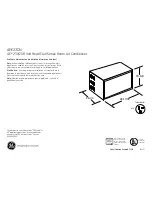
21
AF-S80CX
ELECTRICAL COMPONENT TEST
RUNNING CAPACITOR AND FAN CAPACITOR
CAUTION: DISCHARGE THE RUNNING CAPACITOR AND FAN CAPACITOR BEFORE TOUCHING CAPACITOR
OR WIRING.
COMPRESSOR
(1) Take the wires off compressor terminals.
(2) Set selector switch of volt-ohm-meter on the resistance range.
(3) Put the probes on the terminals of the compressor and check continuity between each terminal.
INSULATION TEST
Check the resistance between the terminals and the copper tube.
Reading must be more than 10M
Ω
at DC 500V.
RUNNING CAPACITOR
FAN CAPACITOR
LEAKS
Several methods are used to detect leaks in systems.
Electronic Leak Detectors are very sensitive and are able to detect leaks down to 1/2 ounce per year.
A good electronic leak detector is generally far better in locating very small leaks.
Halide Torch be sure the room is free from refrigerant vapours. Watch the flame for the slightest change in calor.
A very faint green indicates a small leak. The flame will be unmistakably changed to green or purple when large leaks
are encountered. To simplify leak detection pressurize the system to approximately 75 lbs.
Some leaks can be located by a visual inspection of the system components and solder joints and if oil is found at any
given location it generally is a sign that a leak exists at that point due to the fact that flame does carry oil with it travels
through the system.
Soap Bubbles
Liquid detergents can sometimes assist in finding small leaks by brushing detergent on the suspect area and
watching for bubbles. Before applying detergent be sure that the system is pressurized.
Tap line devices are permissible for diagnosis only they are not suitable when evacuating the system. After the diagnosis
has been made they must be removed so that the system will be restored to a hermeticly sealed condition.
(1) Discharge capacitor by shorting terminals.
(2) Take the wires off the capacitor terminals.
(3) Set the selector switch of a volt-ohm-meter (or a tester)
on the resistance range.
(4) Connect the probes to the capacitor terminals and
watch the indicator swing.
The indicator does not swing at all ..... Open.
The indicator swings but does not return ..... Shorted.
The indicator swings, then returns a moment later .....
Good.
INSULATION TEST
Check the resistance between the terminals and case.
Reading must be more than 10M
Ω
at DC 500V.
OVERLOAD RELAY
Check continuity between terminals with volt-ohm-meter.
INSULATION TEST
Check resistance between terminals and the relay case.
Reading must be more than 10M
Ω
at DC 500V.
















































